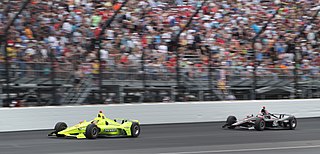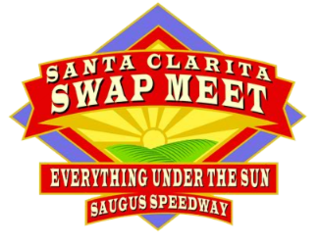
The Indianapolis 500, formally known as the Indianapolis 500-Mile Race, and commonly called the Indy 500, is an annual automobile race held at Indianapolis Motor Speedway (IMS) in Speedway, Indiana, United States, an enclave suburb of Indianapolis. The event is traditionally held over Memorial Day weekend, usually the last weekend of May.

The Indianapolis Motor Speedway is an automobile racing circuit located in Speedway, Indiana in the United States. It is the home of the Indianapolis 500 and the Verizon 200, and formerly the home of the United States Grand Prix. It is located on the corner of 16th Street and Georgetown Road, approximately six miles (9.7 km) west of Downtown Indianapolis.

The United States Grand Prix is a motor racing event that has been held on and off since 1908, when it was known as the American Grand Prize. The Grand Prix later became part of the Formula One World Championship. As of 2021, the Grand Prix has been held 50 times at ten different locations. Since 2012, it has been held every year at the Circuit of the Americas in Austin, Texas, except in 2020 when it was cancelled due to the COVID-19 pandemic in the United States.

Auto Club Speedway, originally opened as California Speedway, is a 2.000 mi (3.219 km), low-banked, D-shaped oval superspeedway in unincorporated San Bernardino County, California, near Fontana. It has hosted NASCAR racing annually since 1997. It was also previously used for open wheel racing events. The racetrack is located 47 mi (76 km) east of Los Angeles and is near the former locations of Ontario Motor Speedway and Riverside International Raceway. The track is owned and operated by NASCAR. The speedway is served by the nearby Interstate 10 and Interstate 15 freeways as well as a Metrolink station located behind the backstretch.

International Race of Champions (IROC) was a North American auto racing competition, created by Les Richter, Roger Penske and Mike Phelps, promoted as an equivalent of an American motorsports All-Star Game. Despite its name, the IROC was primarily associated with North American, oval-track racing.

Raffaele "Ralph" De Palma was an Italian-American racecar driving champion who won the 1915 Indianapolis 500. His entry at the International Motorsports Hall of Fame estimates that he won about 2,000 races. DePalma won the 1908, 1909, 1910, and 1911 American AAA national dirt track championships and is credited with winning 24 American Champ car races. He won the Canadian national championship in 1929. DePalma estimated that he had earned $1.5 million by 1934 after racing for 27 years. He is inducted in numerous halls of fame. He competed on boards and dirt road courses and ovals.

The Vanderbilt Cup was the first major trophy in American auto racing.

American open-wheel car racing, also known as Indy car racing, is a category of professional automobile racing in the United States. As of 2022, the top-level American open-wheel racing championship is sanctioned by IndyCar.

Pikes Peak International Raceway (PPIR) is a racetrack in the Colorado Springs area within the city limits of Fountain, Colorado, that by October 12, 1997, was "the fastest 1-mile paved oval anywhere". The speedway hosted races in several series including the Indy Racing League and two NASCAR series until operations were suspended from 2005–08. A wide variety of amateur racing groups use PPIR for racing and training as the circuit is now closed to sanctioned professional auto racing due to the purchase of the track by PPIR LLC from NASCAR/ISC in 2008 after the track was put up for sale in 2006. The sale included a clause that prohibited sanctioned professional auto racing, as well as the need for additional safety upgrades at a cost of $1 million+ for professional racing series that the new ownership had no interest in implementing with the clause in place.

Johnny Aitken was an American racecar driver from Indianapolis, who was active in the years prior to World War I. Aitken competed in the Indianapolis 500 three times. He started the race twice, in 1911 and 1916. He led the first lap of the first race (1911). Aitken captured the pole position in 1916, but ended up in 15th place that year. In the 1915 Indianapolis 500, Aitken drove relief for two drivers, Gil Anderson and Earl Cooper.

Board track racing was a type of motorsport popular in the United States during the 1910s and 1920s. Competition was conducted on circular or oval race courses with surfaces composed of wooden planks. This type of track was first used for motorcycle competition, wherein they were called motordromes, before being adapted for use by various different types of racing cars. The majority of the American national championship races were contested at such venues during the 1920s.

Robert R. Burman was an American race car driver, he was an open-wheel pioneer, setting numerous speed records in the early 1900s. He participated in many historic races and was one of the drivers to compete in the first edition of the Indianapolis 500 in 1911.

Saugus Speedway is a 1/3 mile racetrack in Saugus, Santa Clarita, California on a 35-acre (140,000 m2) site. The track hosted one NASCAR Craftsman Truck Series event in 1995, which was won by Ken Schrader. Schrader became the first NASCAR driver to win in a race in all three of the sanctioning body's major series, following previous wins in the Winston Cup and Busch Grand National Series. The stadium was closed on July 19, 1995 and no longer holds races.

Race results from the automobile and motorcycle races contested at the Indianapolis Motor Speedway in Speedway, Indiana. Races have been held on seven different track configurations:
Lakewood Speedway was a race track located south of Atlanta, Georgia, in Lakewood, just north of the eastern arm of Langford Parkway. The track held many kinds of races between 1919 and 1979, including events sanctioned by AAA/USAC, IMCA, and NASCAR. It was a one-mile (1.6 km) dirt track which was located adjacent to Lakewood Fairgrounds. Lakewood Speedway was considered the "Indianapolis of the South" as it was located in the largest city in the Southern United States and it held an annual race of the Indy cars.
The 1916 Grand Prix season saw Grand Prix motor racing continue in the United States. Racing was suspended in Europe due to the World War I engulfing the continent. Once again European cars dominated Indianapolis with victory going to Briton Dario Resta in a Peugeot. With the organisers wanting to appeal to the spectators, this was the only year that the race was scheduled for a shorter length – to run only 300 miles. The Vanderbilt Cup and the American Grand Prize returned to Santa Monica, California at the end of the year. Resta repeated his victory from the year before, winning the Vanderbilt Cup. Then when he retired in the Grand Prize it was Howdy Wilcox and Johnny Aitken who won in another of the dominant Peugeots. Oval courses now dominated the AAA Championship with these two events being the only road-course races this year. It proved to be the final time these two formative American races were held in this format, as the Great War dragged the country into the global chaos in 1917. With five victories across the season, the AAA national championship would be retroactively awarded to Dario Resta.

The Harvest Auto Racing Classic was a series of three automobile races held at the Indianapolis Motor Speedway on Saturday September 9, 1916. The meet, held four months after the 1916 Indianapolis 500, featured a 20-mile race, a 50-mile race, and a 100-mile race. The main event, a 100-mile Championship Car race, paid points towards the 1916 AAA National Championship. Johnny Aitken won all three races, two of which had a margin of victory of less than a car length.

Eddie Pullen was an American racing driver who worked for and primarily raced the Mercer marque.
















